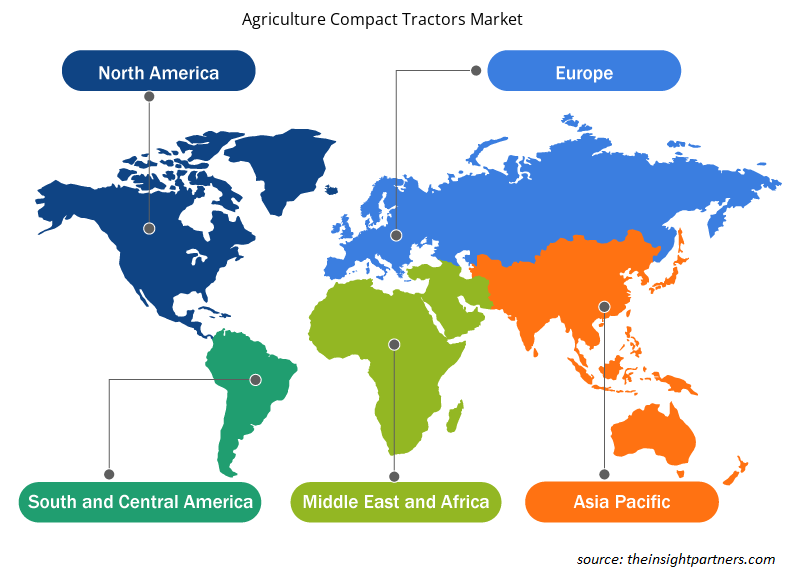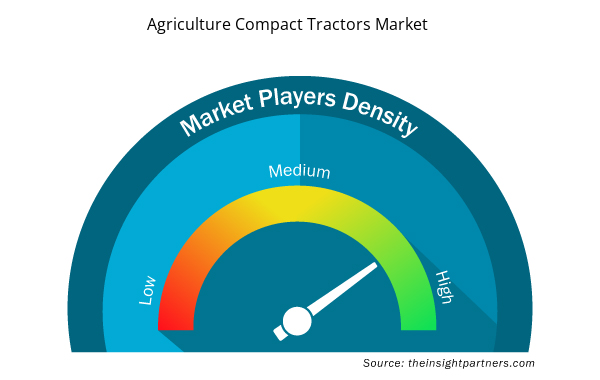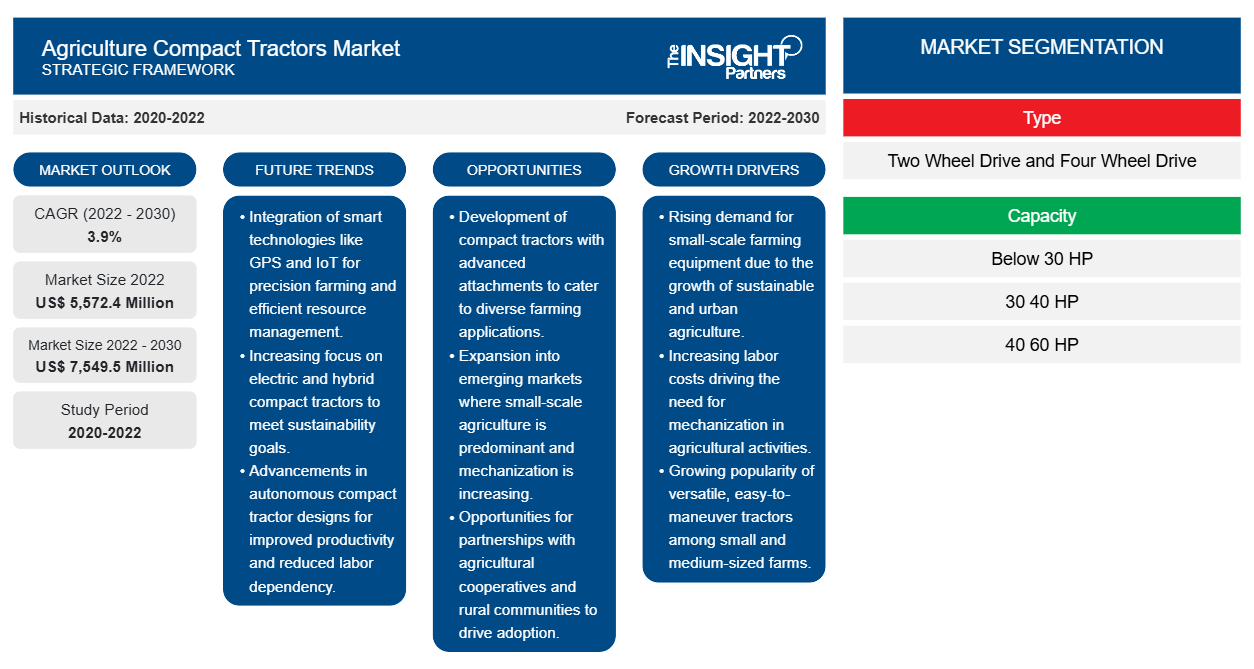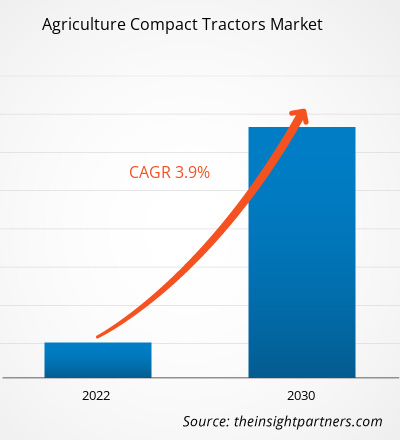[Forschungsbericht] Der Markt für Kompakttraktoren für die Landwirtschaft wird voraussichtlich von 5.572,4 Millionen US-Dollar im Jahr 2022 auf 7.549,5 Millionen US-Dollar im Jahr 2030 wachsen; der Markt wird voraussichtlich von 2022 bis 2030 eine durchschnittliche jährliche Wachstumsrate von 3,9 % verzeichnen.
Analystenperspektive:
Der kontinuierlich wachsende Agrarsektor und die zunehmende Vorliebe für moderne Geräte treiben das Wachstum des globalen Marktes für landwirtschaftliche Kompakttraktoren voran . Mit der kontinuierlich wachsenden Bevölkerung steigt auch die Nachfrage nach Nahrungsmitteln. Laut jüngsten Prognosen der Vereinten Nationen wird die Weltbevölkerung bis 2030 voraussichtlich 8,5 Milliarden erreichen und bis 2050 weiter auf 9,7 Milliarden anwachsen. Infolgedessen steigt die Nachfrage nach landwirtschaftlichen Produkten rapide an, was die Landwirte vor die Herausforderung stellt, die Erträge ihrer Betriebe zu steigern. Daher treibt der zunehmende Umfang der landwirtschaftlichen Aktivitäten die Nachfrage nach landwirtschaftlichen Kompakttraktoren an.
Im Januar 2024 stellte LS Mtron Co., ein südkoreanischer Hersteller von Schwermaschinen und elektronischen Komponenten, die neue Kleintraktorserie MT2·MT2E in Nordamerika vor. Die beiden Modelle dieser Serie – der Premium-MT2 und der preisgünstige MT2E – sind für einen besseren Bedienkomfort auf engstem Raum konzipiert und eignen sich für die Landwirtschaft im kleinen Maßstab. Diese Produktreihe wurde für verschiedene Aufgaben entwickelt, darunter ein einfach zu bedienender Shuttle für reibungslose Vorwärts- und Rückwärtsfahrten und Doppelpedale, die sich zum Transportieren von Erde oder Kies eignen. Solche Produktentwicklungsaktivitäten der Hersteller von landwirtschaftlichen Kompakttraktoren treiben das Wachstum des Marktes für landwirtschaftliche Kompakttraktoren voran.
Marktübersicht:
Kompakttraktoren, die normalerweise als kompakte Nutztraktoren bezeichnet werden, werden hauptsächlich für kleine landwirtschaftliche Tätigkeiten wie Pflügen, Mähen, Pflanzen, Bodenbearbeitung und Transportieren verwendet. Sie sind kleiner in Größe und Kapazität und eignen sich besser für kleine landwirtschaftliche Betriebe, Obst- und Nussplantagen, Weinberge, Gärten und Rasenflächen. Kompakttraktoren verbrauchen weniger Kraftstoff und haben einen geringen Wartungsbedarf, was zu niedrigen Betriebskosten führt.
Der asiatisch-pazifische Raum dominiert den Markt für landwirtschaftliche Kompakttraktoren aufgrund der umfangreichen landwirtschaftlichen Aktivitäten in Ländern wie China und Indien. Allerdings wird erwartet, dass Nordamerika und Europa im Prognosezeitraum starke CAGR-Werte verzeichnen werden. Die USA sind einer der größten Produzenten von Nüssen und Früchten. Laut den vom US-Landwirtschaftsministerium im Jahr 2022 veröffentlichten Daten machten kleine Familienbetriebe 88 % aller landwirtschaftlichen Betriebe in den USA aus. Daher ist die Präsenz einer großen Anzahl kleiner landwirtschaftlicher Betriebe in den USA ein Schlüsselfaktor, der dem Markt für landwirtschaftliche Kompakttraktoren in diesem Land zugute kommt.
Passen Sie diesen Bericht Ihren Anforderungen an
Sie erhalten kostenlos individuelle Anpassungen an jedem Bericht, einschließlich Teilen dieses Berichts oder einer Analyse auf Länderebene, eines Excel-Datenpakets sowie tolle Angebote und Rabatte für Start-ups und Universitäten.
- Holen Sie sich die wichtigsten Markttrends aus diesem Bericht.Dieses KOSTENLOSE Beispiel umfasst eine Datenanalyse von Markttrends bis hin zu Schätzungen und Prognosen.
Markttreiber:
Regierungsinitiativen zur Unterstützung von Kleinbauern
Regierungspolitik und unterstützende Initiativen wie Finanzierungen erhöhen die Zahl der Kleinbauernhöfe in verschiedenen Ländern. So bietet das US-Landwirtschaftsministerium Kleinbauern und Jungbauern ein Mikrokreditprogramm an, das es ihnen ermöglicht, durch einfache Anträge Kredite in Höhe von bis zu 35.000 US-Dollar zu erhalten. Darüber hinaus kündigte die Regierung von Guyana im Jahr 2023 im Rahmen ihres Programms „National Pathway for Food Systems“ eine Initiative an. Im Rahmen dieses Projekts wurden Kleinbauern und Teilnehmern an laufenden sozioökonomischen Stärkungsprogrammen im ganzen Land Betriebsmittel und ein einmaliger Geldzuschuss bereitgestellt. Solche Regierungsinitiativen befähigen Kleinbauern, landwirtschaftliche Geräte, einschließlich Kompakttraktoren, einzusetzen. Darüber hinaus schaffen diese Programme und Initiativen ein förderliches Umfeld für Kleinbauernhöfe in Entwicklungs- und Industrieländern, was letztendlich zu einer Ausweitung des Marktes für landwirtschaftliche Kompakttraktoren führt.
Segmentanalyse:
Die Marktanalyse für landwirtschaftliche Kompakttraktoren wurde unter Berücksichtigung der folgenden Segmente durchgeführt: Typ, Kapazität und Anwendung. Auf der Grundlage der Kapazität ist der Markt in unter 30 PS, 30–40 PS und 40–60 PS segmentiert. Die Segmente 40–60 PS und 30–40 PS machen zusammen mehr als 50 % des Marktanteils landwirtschaftlicher Kompakttraktoren aus. Diese Traktoren eignen sich für mittelgroße landwirtschaftliche Betriebe für Aufgaben wie Pflügen, Bodenbearbeitung, Pflanzen und Ernten. So brachte Farmtrac beispielsweise 2024 seinen neuen Traktor Farmtrac 60 Powermaxx auf den Markt. Dieser Traktor hat einen 55-PS-Motor und bietet mehrere Funktionen.
Regionale Analyse:
Der geografische Umfang des Marktberichts für landwirtschaftliche Kompakttraktoren umfasst Nordamerika (USA, Kanada und Mexiko), Europa (Spanien, Großbritannien, Deutschland, Frankreich, Italien und das übrige Europa), den asiatisch-pazifischen Raum (Südkorea, China, Indien, Japan, Australien und den übrigen asiatisch-pazifischen Raum), den Nahen Osten und Afrika (Südafrika, Saudi-Arabien, Vereinigte Arabische Emirate und den übrigen Nahen Osten und Afrika) sowie Süd- und Mittelamerika (Brasilien, Argentinien und den übrigen Süd- und Mittelamerika). Der asiatisch-pazifische Raum hatte im Jahr 2022 den größten Marktanteil bei landwirtschaftlichen Kompakttraktoren.
Der nordamerikanische Markt für Kompakttraktoren für die Landwirtschaft ist in die USA, Kanada und Mexiko unterteilt. Der Agrarsektor in Nordamerika, insbesondere in Ländern wie den USA, Kanada und Mexiko, treibt die Nachfrage nach Kompakttraktoren für die Landwirtschaft maßgeblich an. Der Ausbau des Agrarsektors und kontinuierliche Produktentwicklungen werden den Markt in dieser Region auch in Zukunft weiter ankurbeln. Laut den vom US-Landwirtschaftsministerium im Jahr 2021 veröffentlichten Daten trug der Agrarsektor im Jahr 2021 etwa 1,264 Billionen US-Dollar zum US-BIP bei, was 5,4 % des nationalen BIP entspricht. Laut den von der kanadischen Regierung im Jahr 2022 veröffentlichten Daten leistet der Agrar- und Agrarlebensmittelsektor einen bedeutenden Beitrag zur kanadischen Wirtschaft. Die kanadischen Agrarrohstoffverkäufe, die jährlich um 5,6 % wachsen, beliefen sich im Jahr 2022 auf 87,7 Milliarden US-Dollar. Die steigende Zahl kleiner landwirtschaftlicher Betriebe führt zu einer größeren Nachfrage nach Kompakttraktoren, was den Anbietern neue Wachstumsmöglichkeiten bietet. Darüber hinaus konzentrieren sich viele wichtige Akteure in den Vereinigten Staaten derzeit auf die Entwicklung vollautomatischer Kompakttraktoren. Solche Entwicklungen dürften in den kommenden Jahren in Nordamerika zu neuen Trends auf dem Markt für Kompakttraktoren für die Landwirtschaft führen.
Regionale Einblicke in den Markt für landwirtschaftliche Kompakttraktoren
Die regionalen Trends und Faktoren, die den Markt für landwirtschaftliche Kompakttraktoren während des gesamten Prognosezeitraums beeinflussen, wurden von den Analysten von Insight Partners ausführlich erläutert. In diesem Abschnitt werden auch die Marktsegmente und die Geografie für landwirtschaftliche Kompakttraktoren in Nordamerika, Europa, im asiatisch-pazifischen Raum, im Nahen Osten und Afrika sowie in Süd- und Mittelamerika erörtert.

- Erhalten Sie regionale Daten zum Markt für landwirtschaftliche Kompakttraktoren
Umfang des Marktberichts für landwirtschaftliche Kompakttraktoren
| Berichtsattribut | Details |
|---|---|
| Marktgröße im Jahr 2022 | 5.572,4 Millionen US-Dollar |
| Marktgröße bis 2030 | 7.549,5 Millionen US-Dollar |
| Globale CAGR (2022 - 2030) | 3,9 % |
| Historische Daten | 2020-2022 |
| Prognosezeitraum | 2022–2030 |
| Abgedeckte Segmente | Nach Typ
|
| Abgedeckte Regionen und Länder | Nordamerika
|
| Marktführer und wichtige Unternehmensprofile |
|
Marktteilnehmerdichte für landwirtschaftliche Kompakttraktoren: Auswirkungen auf die Geschäftsdynamik verstehen
Der Markt für landwirtschaftliche Kompakttraktoren wächst rasant, angetrieben durch die steigende Endverbrauchernachfrage aufgrund von Faktoren wie sich entwickelnden Verbraucherpräferenzen, technologischen Fortschritten und einem größeren Bewusstsein für die Vorteile des Produkts. Mit steigender Nachfrage erweitern Unternehmen ihr Angebot, entwickeln Innovationen, um die Bedürfnisse der Verbraucher zu erfüllen, und nutzen neue Trends, was das Marktwachstum weiter ankurbelt.
Die Marktteilnehmerdichte bezieht sich auf die Verteilung der Firmen oder Unternehmen, die in einem bestimmten Markt oder einer bestimmten Branche tätig sind. Sie gibt an, wie viele Wettbewerber (Marktteilnehmer) in einem bestimmten Marktraum im Verhältnis zu seiner Größe oder seinem gesamten Marktwert präsent sind.
Die wichtigsten auf dem Markt für Kompakttraktoren für die Landwirtschaft tätigen Unternehmen sind:
- YANMAR Traktor
- Mahindra
- TYM CORPORATION
- Solectrac
- John Deere
Haftungsausschluss : Die oben aufgeführten Unternehmen sind nicht in einer bestimmten Reihenfolge aufgeführt.

- Überblick über die wichtigsten Akteure auf dem Markt für landwirtschaftliche Kompakttraktoren
Schlüsselspieleranalyse:
AGCO GmbH, Yamaha Tractors, Solis, Bobcat Company, Mahindra Tractors, Kubota, John Deere, Massey Ferguson und New Holland gehören zu den prominenten Akteuren, die im Marktbericht für landwirtschaftliche Kompakttraktoren vorgestellt werden. Zusätzlich zu diesen Akteuren wurden im Rahmen dieser Studie mehrere andere wichtige Unternehmen untersucht und analysiert, um einen ganzheitlichen Überblick über den globalen Markt für Nutz-Kompakttraktoren zu erhalten.
Aktuelle Entwicklungen:
Anorganische und organische Strategien wie Fusionen und Übernahmen werden von Unternehmen auf dem globalen Markt für landwirtschaftliche Kompakttraktoren häufig eingesetzt. Nachfolgend sind einige aktuelle Entwicklungen der wichtigsten Akteure auf dem Markt für landwirtschaftliche Kompakttraktoren aufgeführt, die in Pressemitteilungen veröffentlicht wurden:
Jahr | Nachricht | Region |
August 2023 | Case IH hat seine neuen Farmall Subcompact 25SC-Traktoren vorgestellt. Dieses neu eingeführte Modell ist der kleinste Traktor im Portfolio von Case IH. Der neue Traktor verfügt über eine Motorleistung von 25 bis 115 PS. | Asien & Pazifik |
Februar 2023 | Bobcat hat eine neue Kompakttraktorreihe mit der Bezeichnung 1000, 2000 und 4000 eingeführt. Die Serie umfasst neun Kompakttraktormodelle, die sich anhand der Motorleistung unterscheiden. Diese Traktoren haben einen Leistungsbereich von 25 bis 85 PS. | Europa |
- Historische Analyse (2 Jahre), Basisjahr, Prognose (7 Jahre) mit CAGR
- PEST- und SWOT-Analyse
- Marktgröße Wert/Volumen – Global, Regional, Land
- Branche und Wettbewerbsumfeld
- Excel-Datensatz



Report Coverage
Revenue forecast, Company Analysis, Industry landscape, Growth factors, and Trends

Segment Covered
This text is related
to segments covered.

Regional Scope
North America, Europe, Asia Pacific, Middle East & Africa, South & Central America

Country Scope
This text is related
to country scope.
Häufig gestellte Fragen
Continuous adoption of electric vehicles owing to increased focus on sustainability is one of the trends that is expected to drive the demand of the electric agriculture compact tractors market.
AGCO GmbH, Yamaha Tractors, Solis, Bobcat Company, Mahindra Tractors, Kubota, John Deere, Massey Ferguson, and New Holland are the key market players operating in the global agriculture compact tractors market.
Regions such as Europe, North America and Asia-Pacific will boost the growth of the agriculture compact tractors market during the forecast period. This growth is owing to the rise in investment for the adoption of the modern agriculture equipment and vineyards in the regions.
Many compact tractor manufacturers are focusing on developing fully automated compact tractors. Such development is projected to generate lucrative opportunities for the agriculture compact tractors market during the forecast period.
High customization options and low cost of compact tractors are a few of the factors contributing to the expansion of the agriculture compact tractors market size. Farming requires a wide range of agricultural equipment, and tractors form an unintegral part of this set of equipment. Purchasing various farm equipment can be expensive, whereas low prices of a small tractor provide some relief to agriculturists and farm owners. Lower price is especially a primary factor driving the adoption of agriculture compact tractors in in agriculture-dominating economies such as China and India, which are home to numerous small and low-margin farmers.
Trends and growth analysis reports related to Manufacturing and Construction : READ MORE..
The List of Companies - Agriculture Compact Tractors Market
- YANMAR Tractor
- Mahindra
- TYM CORPORATION
- Solectrac
- John Deere
- AGCO GmbH
- Bobcat Company
- New Hollland
- Massey Ferguson
- TAFE
- Jinma Tractor
- LANSU
The Insight Partners performs research in 4 major stages: Data Collection & Secondary Research, Primary Research, Data Analysis and Data Triangulation & Final Review.
- Data Collection and Secondary Research:
As a market research and consulting firm operating from a decade, we have published and advised several client across the globe. First step for any study will start with an assessment of currently available data and insights from existing reports. Further, historical and current market information is collected from Investor Presentations, Annual Reports, SEC Filings, etc., and other information related to company’s performance and market positioning are gathered from Paid Databases (Factiva, Hoovers, and Reuters) and various other publications available in public domain.
Several associations trade associates, technical forums, institutes, societies and organization are accessed to gain technical as well as market related insights through their publications such as research papers, blogs and press releases related to the studies are referred to get cues about the market. Further, white papers, journals, magazines, and other news articles published in last 3 years are scrutinized and analyzed to understand the current market trends.
- Primary Research:
The primarily interview analysis comprise of data obtained from industry participants interview and answers to survey questions gathered by in-house primary team.
For primary research, interviews are conducted with industry experts/CEOs/Marketing Managers/VPs/Subject Matter Experts from both demand and supply side to get a 360-degree view of the market. The primary team conducts several interviews based on the complexity of the markets to understand the various market trends and dynamics which makes research more credible and precise.
A typical research interview fulfils the following functions:
- Provides first-hand information on the market size, market trends, growth trends, competitive landscape, and outlook
- Validates and strengthens in-house secondary research findings
- Develops the analysis team’s expertise and market understanding
Primary research involves email interactions and telephone interviews for each market, category, segment, and sub-segment across geographies. The participants who typically take part in such a process include, but are not limited to:
- Industry participants: VPs, business development managers, market intelligence managers and national sales managers
- Outside experts: Valuation experts, research analysts and key opinion leaders specializing in the electronics and semiconductor industry.
Below is the breakup of our primary respondents by company, designation, and region:

Once we receive the confirmation from primary research sources or primary respondents, we finalize the base year market estimation and forecast the data as per the macroeconomic and microeconomic factors assessed during data collection.
- Data Analysis:
Once data is validated through both secondary as well as primary respondents, we finalize the market estimations by hypothesis formulation and factor analysis at regional and country level.
- Macro-Economic Factor Analysis:
We analyse macroeconomic indicators such the gross domestic product (GDP), increase in the demand for goods and services across industries, technological advancement, regional economic growth, governmental policies, the influence of COVID-19, PEST analysis, and other aspects. This analysis aids in setting benchmarks for various nations/regions and approximating market splits. Additionally, the general trend of the aforementioned components aid in determining the market's development possibilities.
- Country Level Data:
Various factors that are especially aligned to the country are taken into account to determine the market size for a certain area and country, including the presence of vendors, such as headquarters and offices, the country's GDP, demand patterns, and industry growth. To comprehend the market dynamics for the nation, a number of growth variables, inhibitors, application areas, and current market trends are researched. The aforementioned elements aid in determining the country's overall market's growth potential.
- Company Profile:
The “Table of Contents” is formulated by listing and analyzing more than 25 - 30 companies operating in the market ecosystem across geographies. However, we profile only 10 companies as a standard practice in our syndicate reports. These 10 companies comprise leading, emerging, and regional players. Nonetheless, our analysis is not restricted to the 10 listed companies, we also analyze other companies present in the market to develop a holistic view and understand the prevailing trends. The “Company Profiles” section in the report covers key facts, business description, products & services, financial information, SWOT analysis, and key developments. The financial information presented is extracted from the annual reports and official documents of the publicly listed companies. Upon collecting the information for the sections of respective companies, we verify them via various primary sources and then compile the data in respective company profiles. The company level information helps us in deriving the base number as well as in forecasting the market size.
- Developing Base Number:
Aggregation of sales statistics (2020-2022) and macro-economic factor, and other secondary and primary research insights are utilized to arrive at base number and related market shares for 2022. The data gaps are identified in this step and relevant market data is analyzed, collected from paid primary interviews or databases. On finalizing the base year market size, forecasts are developed on the basis of macro-economic, industry and market growth factors and company level analysis.
- Data Triangulation and Final Review:
The market findings and base year market size calculations are validated from supply as well as demand side. Demand side validations are based on macro-economic factor analysis and benchmarks for respective regions and countries. In case of supply side validations, revenues of major companies are estimated (in case not available) based on industry benchmark, approximate number of employees, product portfolio, and primary interviews revenues are gathered. Further revenue from target product/service segment is assessed to avoid overshooting of market statistics. In case of heavy deviations between supply and demand side values, all thes steps are repeated to achieve synchronization.
We follow an iterative model, wherein we share our research findings with Subject Matter Experts (SME’s) and Key Opinion Leaders (KOLs) until consensus view of the market is not formulated – this model negates any drastic deviation in the opinions of experts. Only validated and universally acceptable research findings are quoted in our reports.
We have important check points that we use to validate our research findings – which we call – data triangulation, where we validate the information, we generate from secondary sources with primary interviews and then we re-validate with our internal data bases and Subject matter experts. This comprehensive model enables us to deliver high quality, reliable data in shortest possible time.


 Holen Sie sich ein kostenloses Muster für diesen Bericht
Holen Sie sich ein kostenloses Muster für diesen Bericht